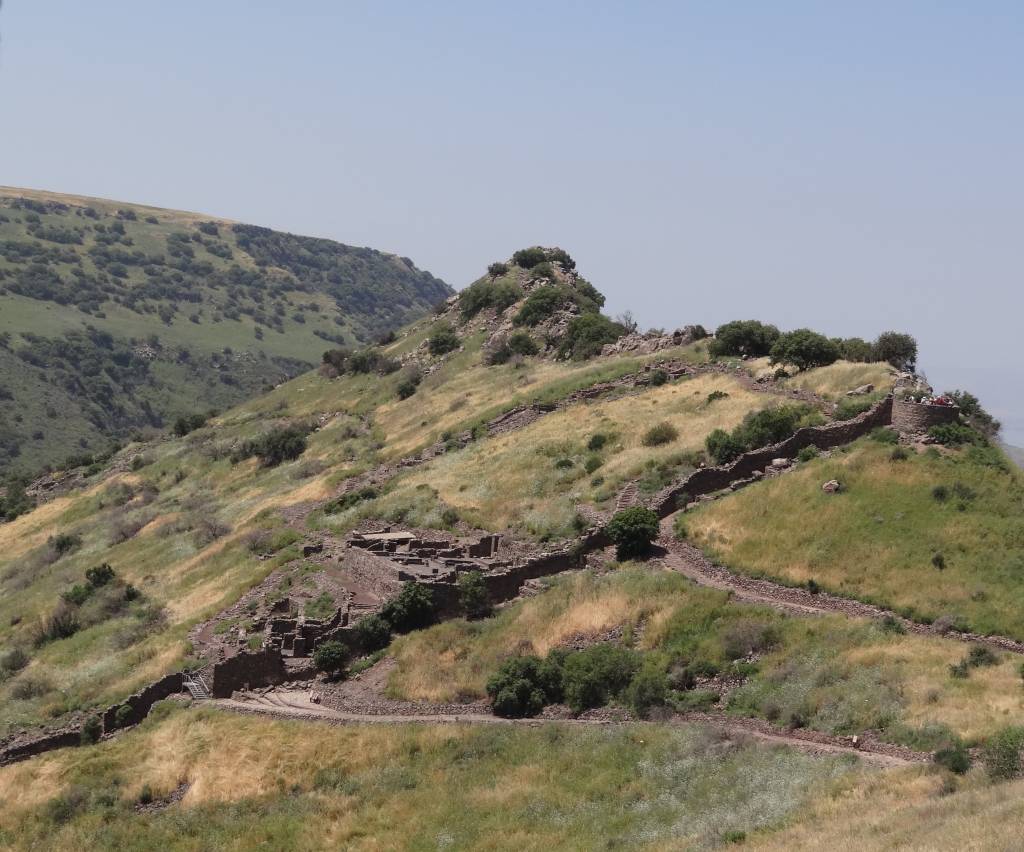Less known than Masada, but with a similar story of courage and resistance, the ancient Jewish city of Gamla, located in the Golan Heights, was one of the first communities to fall to the Romans.
The second most visited site in Israel is the desert fortress of Masada. The story of the small group of Jews and their desperate stand against the powerful Roman army is compelling. Masada fell in 73 CE, three years after the destruction of the Second Temple and Jerusalem. After bravely holding out against the Romans, the hold-out at Masada ends with the approximately one-thousand Jewish inhabitants taking their own lives in order to die as free people rather than subject themselves to the brutality of the Romans.
Masada has a twin site in the north that is called Gamla, which is actually referred to as the “Masada of the North.” While Masada is a very high traffic site and its story well known, Gamla does not attract nearly as many visitors, nor is its story as popular. Perhaps we can begin to change that by exploring the history of Gamla.
Gamla was an ancient city that most agree was founded during the 3rd century BCE. Gamla, though, is most famous for its strong stand against the Romans in the Great Revolt of 66 CE. Beginning in the city of Caesaria, the Jews began a revolt against the Roman occupation of the Land of Israel. The revolt was the result of years of Roman financial exploitation, contempt for Judaism, persecution of Jews and disrespect for the Temple.
The Roman strategy for crushing the revolt was to focus its forces first on the north – the Galilee and the Golan. The idea was to crush the rebels absolutely with extreme brutality, which was meant to discourage the Jews in the center and southern parts of the country and to convince them to end the rebellion.
After sweeping across the country from west to east, the Roman legions came to Gamla. Gamla was built on a steep hill shaped like the hump of a camel, hence the name Gamla (Gamal is the Hebrew word for camel). Gamla is surrounded by steep ravines and is only approachable by a footpath on the northeastern side. Masada, too, was only approachable by a footpath that was referred to as the snake path.
Considering that the Roman attack could only come from the one side, the residents fortified the wall on the eastern side. The Roman general Vespasian attacked the city for a month and finally breached the wall. His success was short-lived when many soldiers in the Roman army were killed and they were forced to withdraw.
On the second attempt, the Romans managed to breach the wall in three locations and flooded the city with soldiers. According to ancient historian Flavius Josephus, the defenders retreated up the steep hill and again successfully fought off the Roman army from the superior position, thus forcing a withdrawal.
In the third attempt, the Romans were not to be denied. They re-entered the city and ended the Jewish resistance, slaughtering thousands of inhabitants. The remaining 5,000 were killed either falling down into the ravine while trying to escape or intentionally leaping to their deaths to avoid capture.
In the Great Revolt, which would end tragically for the Jewish people, Gamla was one of the first towns to fall to the Romans. It was a heroic defense that in the final analysis had little chance of success against the powerful Roman legions. Masada was the last stand of the Great Revolt that also had very little chance of success. Gamla and Masada are the bookends to one of the darkest chapters in Jewish history. What began with high hopes ended with destruction and an exile that would last nearly 2,000 years.
It wasn’t until the modern State of Israel was declared in 1948 and the Golan Heights redeemed in the Six Day War that Gamla would be rediscovered. Gamla was excavated between the years 1977 and 2000, and the remains of a typical Jewish city were discovered, including, for example, a synagogue, ritual baths and ancient coins. Additionally, remains from the battle were discovered such as catapults, arrow heads, ballista stones in quantities greater than anywhere else in the Roman Empire. When visiting Gamla there is a lot to see. You can walk through the synagogue, see the breach wall where the Romans entered the city, ritual baths and residences to name just a few.
At Gamla, if you listen carefully, you can still hear the echo of the defenders. They dreamed of liberating Israel from the Roman occupation, and while they did not live to see this happen, their dreams would be fulfilled. After nearly 2,000 years, their descendants returned to the land to live freely and in control of their own destiny.
By: Moshe Rothchild, licensed tour guide
